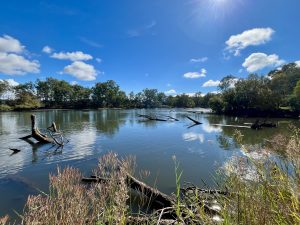Parklands has been busy removing pest plants, revegetating, and installing stock-exclusion fencing along our local rivers and wetlands. Both the Murray and Kiewa Rivers along with their associated riverine landscapes are major features of our local area and are rich in biodiversity and Aboriginal cultural heritage, so it’s vitally important that we protect these areas for the future. The works being undertaken are part of two separate projects – one of which focuses on the Murray River corridors along the Project 66 route, and the other specifically targeting parts of the Kiewa River wetlands and waterways. Project 66 is an ambitious project that aims to take advantage of the fantastic natural assets along the Murray River by providing 66 km of public access recreational trails, from the Wagirra Trail in Albury all the way to Lake Hume. You can watch an overview of Project 66 here.
Controlling pest plants along both the Project 66 trail and the Kiewa River is a priority as it will improve biodiversity values and habitat for native fauna simply by creating space for more native flora to regenerate in areas currently covered by invasive weeds. Broadleaf and woody weeds were targeted along the Murray River corridors in places such as Browns Island, pictured here.


Black willows are one of the most invasive species impacting the Kiewa River Catchment and you can read about how we have been tackling those here. Targeted control of black willows and other invasive weeds will reduce the threatening processes to local biodiversity and we had good success with weed control within the Kiewa River Regional Park, pictured below.






At the same time, planting of native seedlings will contribute to the absorption of carbon as they grow, increase the number of trees for habitat in the longer term, and increase the availability of food for native birds, reptiles, and mammals throughout the year with a diversity of shrubs flowering each season. To improve the success rate of seedlings, these plants are sourced from hotter, drier areas of their provenance in order to cope with a warming climate.
Grazing is also one of the biggest threats to biodiversity, so stock-exclusion fencing has been put in place to protect sensitive areas from damage. Fencing will also provide safe corridors for native fauna to travel across country and therefore adapt to a changing climate. Pictured here are some lengths of fencing around wetlands near Carrolls Lane, West Wodonga.


These projects are funded by grants from the Victorian Government and the Department of Energy, Environment, and Climate Action, with the first 12 months of a two-year timeline now complete.






